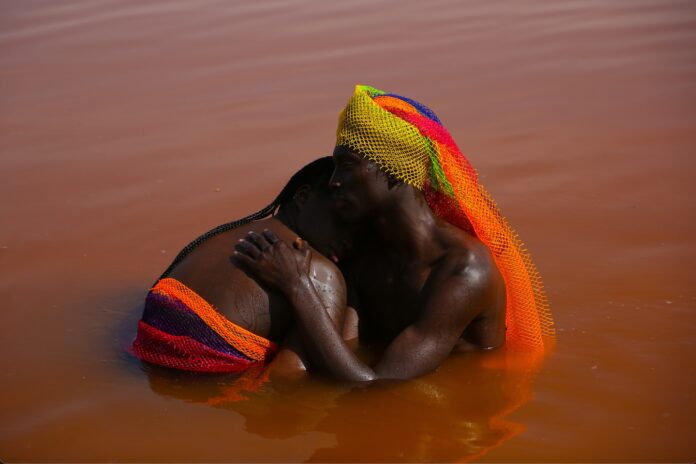Two of the photographs in Drame’s “More True Than Fact” are black-and-white, but most are rich with color, whether natural or synthetic. The Senegalese photographer, who lived in Los Angeles but has returned to Dakar, made several of the pictures on a beach in Ghana. These photos are keyed to earth, water and flesh tones. In one, a brown-skinned man dressed in white faces away from the viewer and toward the surf, hefting on his shoulder a cream-colored goat that, the artist said in an interview, represents oppression.
Fabric is typically the brightest element in a Drame picture and eyes are the rarest. A woman is draped in jewelry and an orange robe that covers most of her face, while setting off the pale-blue sky behind her. A man dressed in flowing white looks away from the photographer and toward a red-and-blue-striped cloth backdrop. A young man on a motorbike wears a bright-red T-shirt and a horned gold plastic helmet as he gazes at the camera through eyes hidden behind a black-lensed visor.
The contemporary elements of that last photo, which is set in a ramshackle market area, are not typical of the artist’s work. He clearly prefers the traditional, the symbolic and the mythological. “More True Than Fact” can be seen as a voyage into a cherished past, paralleling Drame’s actual journey home.
Wondemu is based in the D.C. area but travels regularly to Ethiopia, her homeland. Her Photoworks show, “In Syzygy,” includes examples of three series, including “Modern Muses.” These are somber, dignified portraits of women, most holding flowers or plants, that were made in Addis Ababa. On the opposite wall are pictures of flower arrangements or close-ups of blooms. Both series are monochromatic, although some of the flower studies have been toned with washes made from tea, coffee or avocados.
The photographer usually shoots with film and makes her own silver- or platinum-based prints using techniques that were standard before digital imaging largely supplanted them. The vegetable-derived washes are a “commentary on a wider use of image manipulation,” according to Wondemu’s statement.
The dancing self-portraits, however, were made with digital negatives. The photographer contact-printed them as blueprint-like cyanotypes at Photoworks, where she is artist-in-residence. The photos are collectively titled “Phoenix,” suggesting that Wondemu is pirouetting toward rebirth. But the pictures also work as exquisite technical exercises, conveying texture and movement as much as their specific subject. Where Drame photographs individuals as exemplars of a larger culture, Wondemu’s “Phoenix” series renders mythic a single whirling person.
Djibril Drame: More True Than Fact Though Sept. 4 at Mehari Sequar Gallery, 1402 H St. NE. meharisequargallery.com.
Redeat Wondemu: In Syzygy Through Sept. 4 at Photoworks, Glen Echo Park, 7300 MacArthur Blvd., Glen Echo. glenechophotoworks.org. 301-634-2274.
History is part of the undergrowth in Tinam Valk’s dreamlike paintings. The mixed-media pictures in “Obscura,” her Athenaeum show, share some watery qualities with the ones she exhibited last year at Portico Gallery. But where that set placed the viewer amid stormy seas, this group often depicts a gentler, more ambiguous domain: low-lying wetlands punctuated by meandering rivers and streams, sometimes populated by boaters or bathers who wear old-timey clothing.
The apparel is explained by one source of the scenes: photographs that are as much as a century old. Valk is a longtime Washingtonian, but she was born in Berlin and is of German, Dutch and Indonesian heritage. Some of these paintings are titled after places in the Berlin area and probably depict them as they were — or as the artist imagines them — in more rustic times.
The pictures’ mythic depths are partly symbolized by actual ones. Valk applies paint thickly, and incorporates dirt, modeling paste and botanical specimens into the impastoed pigment. If the figures are somewhat ghostly, the medium is solid and earthy. The people have evaporated, but the landscape chunkily endures.
Tinam Valk: Obscura Through Sept. 3 at the Athenaeum, 201 Prince St., Alexandria. nvfaa.org. 703-548-0035.
Female nudes are employed to very different effect in the works of two of “The Three Graces,” a trio of women artists new to Zenith Gallery. Marija Djakovic employs a style influenced by early cubism to paint women who are often undraped and usually solitary — save for a cat, a bird, or a plant or two. Mitzi Bernard tightly interlaces dozens of photos of unclad women in girlie-magazine poses into collages, where their willowy bodies become strands of such nonhuman things as a horse’s mane or a bird’s plumage.
Djakovic’s imagery is flat and attenuated, but heightened dramatically by color. Her “Animal Dream,” a show highlight, tints pink skin with green, suffusing the entire composition with garden hues. Bernard’s color schemes appear more naturalistic from a distance, but close inspection reveals that the constituent swirls and squiggles are in many colors, including rosy thighs, red blossoms and a white-on-black Playboy logo. Bernard redefines the tiny pictures she assembles but leaves clues of their origins.
There’s a sensuousness to the work of the third contributor, Barbara Baron Rubin, but it has nothing to do with flesh or feathers. The artist arrays on black backdrops abstract patterns of three-dimensional 23-karat gold. She occasionally introduces other colors, but her most striking works are just black and gold, the latter molded and gleaming. Whether the metal takes the forms of a distorted checkerboard or two concentric circles joined by a slash, the patterns are dynamic and the color contrasts vivid.
The Three Graces Through Sept. 2 at Zenith Gallery, 1429 Iris St. NW. zenithgallery.com. 202-783-2963.



